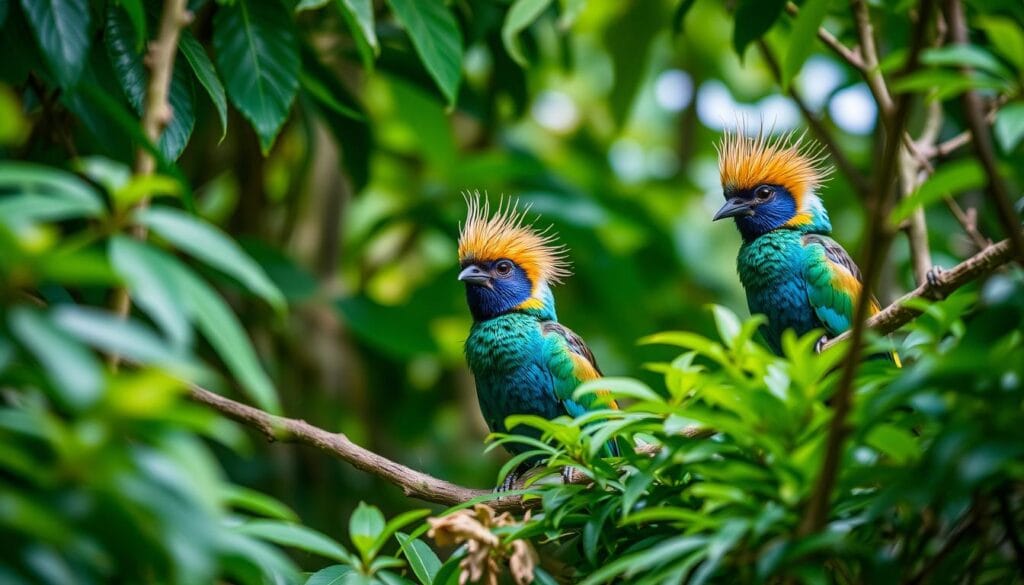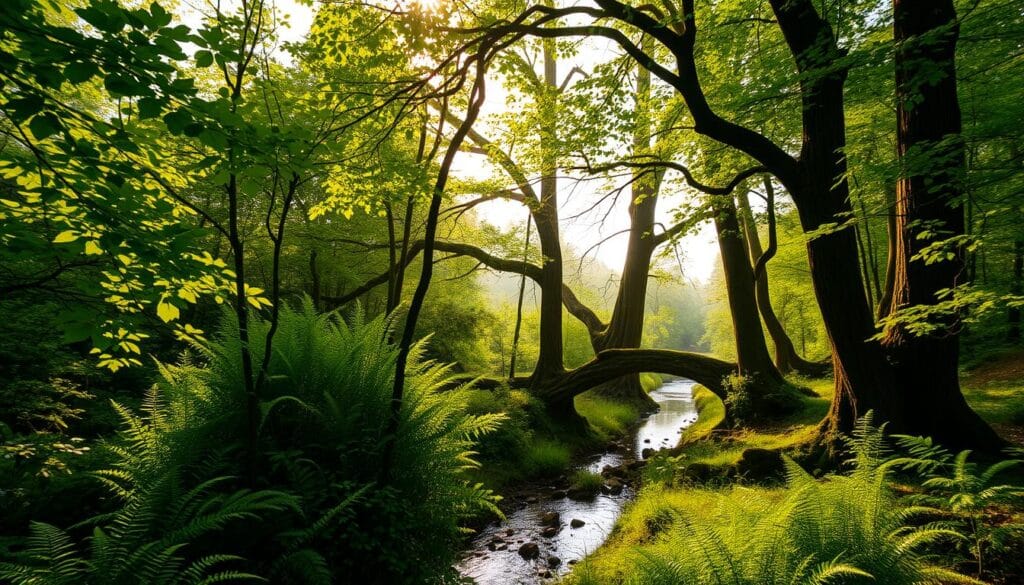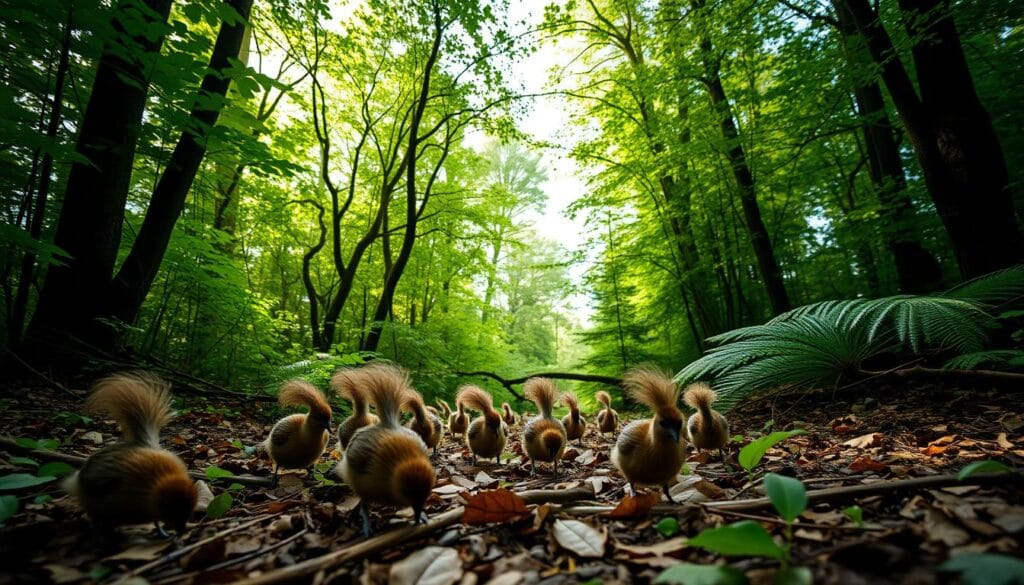Discover the Fascinating World of Crested Woodland Birds: A Guide for Birdwatchers

Have you ever stood in a forest, watching birds dance in the air? Their crests flash brightly against the green leaves. Crested woodland birds are nature’s most captivating creatures. Each one has a story of survival and adaptation.
These birds live in forests all over the world. From North America to Europe and Asia, they call these places home. Their crests are not just pretty. They help these birds talk to each other in their complex social worlds.
Meet the Blue Jay with its stunning blue feathers and movable crest. There’s the Great Curassow, a majestic bird of the tropical forests. And let’s not forget the social Cockatoos of Australia. These birds show us the amazing diversity of crested woodland birds. Each one offers a peek into their complex behaviors and survival strategies.
Table of Contents
What is the crested woodland bird with three letters?
Exploring tufted birds in forests is thrilling for bird lovers and nature fans. A small bird has caught the eye of crossword fans and bird experts. It’s a bird that lives in the woods.
The Jay: A Three-Letter Woodland Wonder
The bird you’re looking for is the Jay. These birds are smart and look unique, especially with their crests. Their crests make them stand out in the forest.
- Intelligent woodland dwellers
- Prominent crest features
- Often featured in crossword puzzles
Jay Species and Characteristics
Jays are part of the Corvidae family and live in many woodlands. They have bright colors and are very smart. This makes them special among forest birds.
“Nature’s puzzle solvers, Jays are more than just a three-letter word.” – Ornithology Insights
Crest Types and Identification
When spotting Jays, look at their crests. The size and shape of the crest can differ. It helps them look good and function well in their homes.
| Jay Species | Crest Description | Habitat Range |
|---|---|---|
| Blue Jay | Prominent blue-gray crest | Eastern North America |
| Steller’s Jay | Dark crest with black and blue | Western Mountain Forests |
Next time you see a crossword or walk in the woods, you’ll know more about these interesting birds. They add life to the forest.
Physical Characteristics and Adaptations
Crested woodland birds are a fascinating group of birds. They have developed amazing adaptations to live in different forest environments. Their unique looks make them stand out in woodland ecosystems.
Exploring crested woodland birds, you’ll find incredible adaptations. Their crests help with communication and camouflage in dense forests.
The Crested Tit of Scotland
The Crested Tit (Lophophanes cristatus) is a great example of these birds’ adaptations. Found in Scottish coniferous forests, it has unique traits:
- Distinctive black-and-white crest
- Compact body size ideal for forest navigation
- Specialized beak for extracting insects from tree bark
British Crested Bird Species
In Britain, crested woodland birds show a lot of diversity. Some notable species are:
- Crested Tit
- Great Spotted Woodpecker
- Long-tailed Tit
“Each crested woodland bird represents a unique marvel of evolutionary adaptation” – Ornithological Research Journal
Knowing about these birds’ physical traits helps birdwatchers see how they’ve adapted to forest life.
Habitat Requirements and Distribution of Crested Woodland Birds
Crested woodland birds are fascinating. They adapt well to different forest habitats. These birds have clever ways to survive in various environments.
Preferred Forest Types
Each crested woodland bird prefers certain forests. They like:
- Coniferous forests with dense canopies
- Deciduous woodlands with mixed trees
- Transitional zones with complex environments
Geographic Range and Migration Patterns

Crested woodland birds live on many continents. They have unique migration patterns. Some interesting facts include:
- Sub-Saharan African crested barbets live in 14 countries
- Sulphur-crested Cockatoos are found across Australia
- North American species migrate with the seasons
Nesting Habits and Territory Selection
Crested woodland birds have complex breeding habits. They choose territories carefully and build nests with skill. They also live in social groups for safety.
- They pick territories based on food availability
- They build nests with great care
- They live in groups for protection
“The forest is not just a habitat, but a complex ecosystem supporting intricate avian life cycles.” – Ornithological Research Journal
| Bird Species | Breeding Season | Clutch Size | Incubation Period |
|---|---|---|---|
| Crested Barbet | September-December | 1-5 eggs | 13-17 days |
| Sulphur-crested Cockatoo | May-January | 2-3 eggs | 9-12 weeks |
Knowing their habitat needs helps us protect these amazing birds. It’s key to their survival in the forest.
Behavior and Feeding Habits
Crested woodland birds have amazing behaviors that make them interesting in forest ecosystems. Woodpeckers and tufted birds have special ways to find food. These strategies help them live in the complex world of woodlands.

These birds have different ways to eat, showing their unique skills. Woodpeckers use their strong beaks to:
- Drill into tree bark to find insects
- Get larvae from wood cavities
- Make homes in tree trunks
Tufted birds have clever ways to hunt for food. Their diet includes:
- Insects and small invertebrates
- Seeds and nuts
- Berries and fruits
- Small vertebrates sometimes
“Nature has equipped these woodland birds with extraordinary survival skills that allow them to thrive in challenging forest environments.” – Ornithological Research Institute
Social interactions are key to their survival. Many woodpeckers talk to each other by drumming. This drumming marks their territory and attracts mates.
| Bird Species | Primary Food Source | Foraging Technique |
|---|---|---|
| Black-crested Titmouse | Insects, Seeds | Canopy Gleaning |
| Great Crested Flycatcher | Flying Insects | Aerial Hunting |
| Woodpeckers | Wood-boring Insects | Bark Drilling |
Learning about these behaviors helps us understand their role in forests. They play a big part in keeping forests diverse.
Conclusion
Crested woodland birds are more than just pretty faces. They play a key role in keeping forests healthy. They help spread seeds, control bugs, and keep biodiversity alive in different places.
Our help is needed to keep these birds alive. Birds like Blue Jays show off their smart ways of talking. Others, like the Oak Titmouse, eat a wide range of foods. You can help by watching birds, joining science projects, or supporting wildlife groups.
It’s important to keep learning about these birds and their homes. By doing so, you help spread the word about why they matter. Every little bit helps, whether it’s through local groups or big organizations.
Our actions today will shape the future of these birds. Your interest and love for them can help protect their homes. Together, we can keep the balance of nature for future generations.
